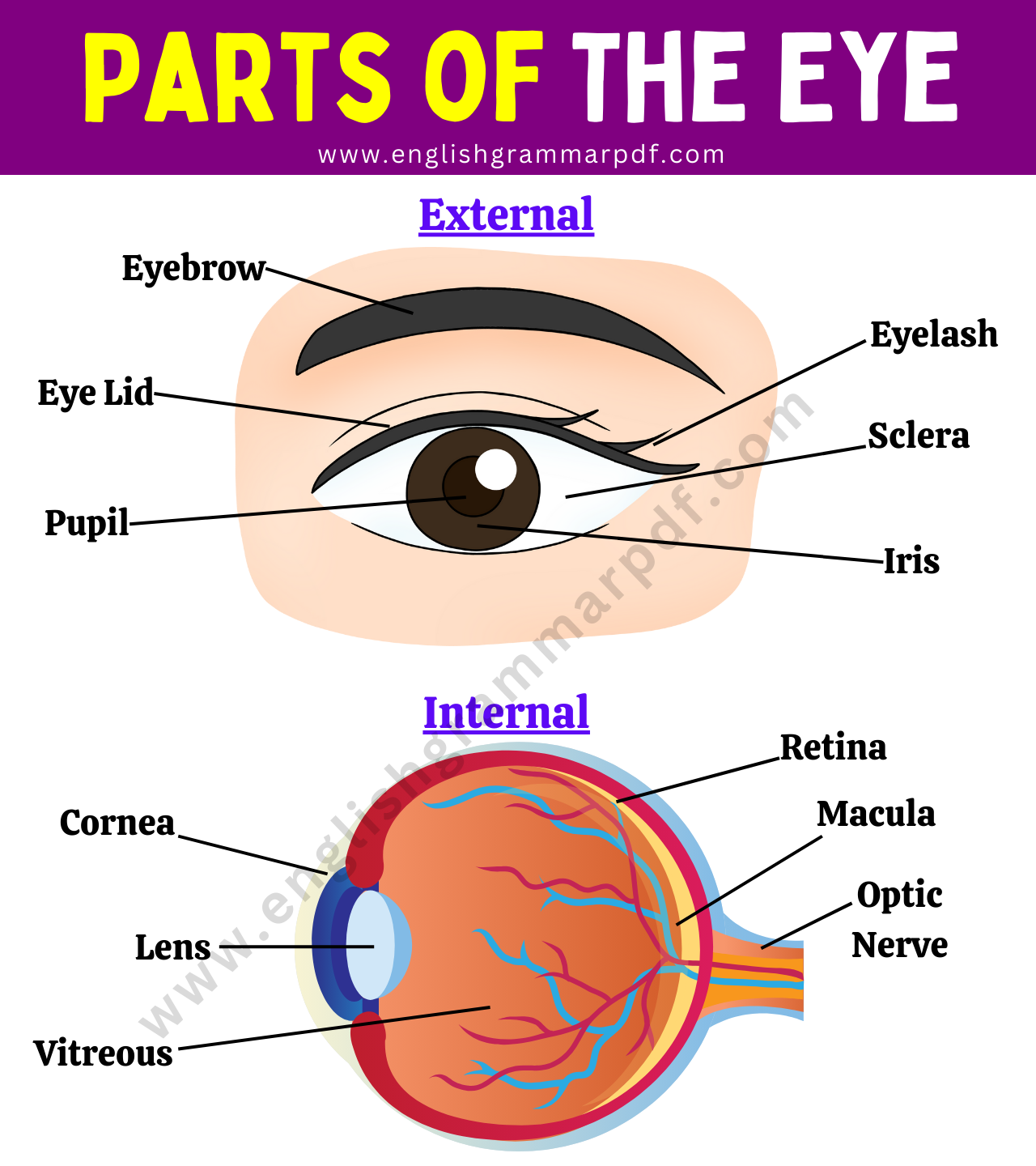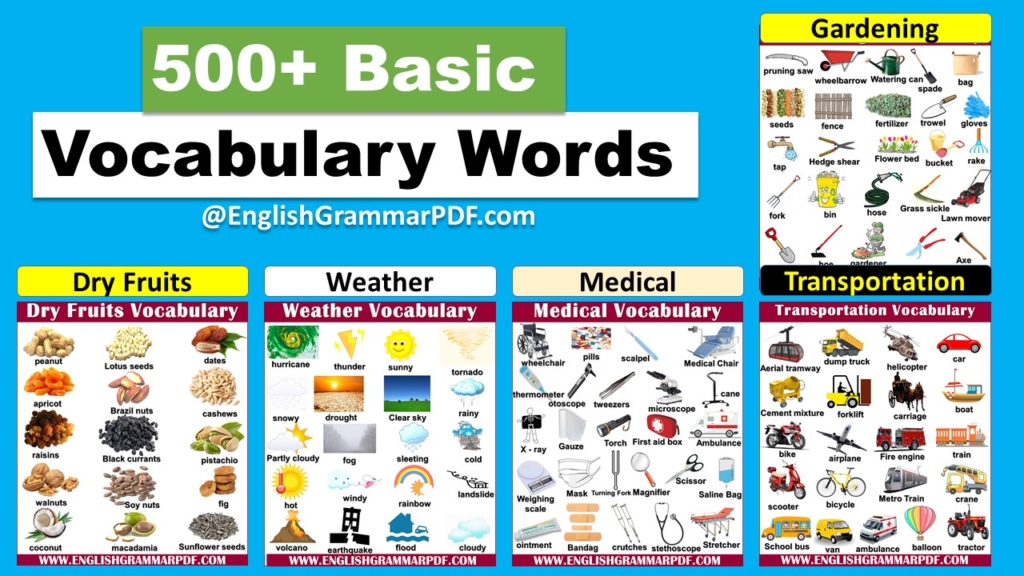The eye is a special part of our body that lets us see the world around us. It’s like a camera that captures pictures of everything we look at. There are two main parts of the eye: the outside, which includes parts we can see and touch, and the inside, where all the magic of seeing happens.
Learning about these parts can be fun and interesting. It helps us understand how we can see our friends, colors, and everything else. Let’s learn these parts in a simple way with their pictures so you can understand.
Parts of the Eye
Here is the list of different parts of the eye with meanings in English:
- Cornea: The clear, dome-shaped surface that covers the front of the eye and helps to focus incoming light.
- Iris: The colored part of the eye, which contains muscles that adjust the size of the pupil to control the amount of light entering the eye.
- Pupil: The opening in the center of the iris through which light enters the eye.
- Lens: A clear, flexible structure behind the iris and pupil that changes shape to focus light onto the retina.
- Retina: The light-sensitive layer of tissue at the back of the eye, which converts light into electrical signals.
- Optic Nerve: The bundle of nerve fibers that transmits visual information from the retina to the brain.
- Sclera: The white, opaque outer layer of the eye that provides protection and structure.
- Conjunctiva: A thin, transparent membrane that covers the sclera and lines the inside of the eyelids.
- Vitreous Humor: The clear, jelly-like substance that fills the space between the lens and the retina.
- Choroid: A layer of blood vessels between the retina and the sclera that provides oxygen and nutrients to the eye.
- Macula: A small, specialized area on the retina responsible for central vision and high-resolution color vision.
- Fovea: The central part of the macula that provides the sharpest vision and is crucial for tasks requiring detailed vision, such as reading.
- Ciliary Body: A ring-shaped tissue behind the iris that is connected to the lens, helping to control its shape for focusing.

Cornea
The cornea is the clear, front part of the eye that covers the iris and pupil. Think of it like a window that lets light into a room. It has a special shape that helps bend the light, which is important for focusing on what we see. The cornea is very strong but can repair itself quickly if it gets a small scratch. Keeping the cornea clean and protected is key to clear vision.
Iris
The iris is the colored part of the eye that surrounds the pupil. It works like the shutter of a camera, controlling how much light enters the eye. The iris can change the size of the pupil to let in more or less light, depending on whether it’s bright or dark around us. The color of the iris is what gives people different eye colors, like blue, green, or brown.
Pupil
The pupil is the black dot in the center of the iris. It’s actually a hole that lets light pass through to the back of the eye. When there’s a lot of light, the pupil becomes smaller to let in less light. In the dark, it gets bigger to let in more light. This helps us see better in different lighting conditions.
Lens
The lens is a clear part of the eye behind the iris that helps focus light onto the retina. It changes shape to help us see things that are close or far away clearly. As we age, the lens can become less flexible, making it harder to see things up close. This is a normal part of getting older for many people.
Retina
The retina is like a screen at the back of the eye where images are projected. It’s made of special cells that detect light and color. These cells send signals to the brain about what we’re seeing, and the brain puts these signals together to make pictures. Without the retina, we wouldn’t be able to see anything at all.
Optic Nerve
The optic nerve is like a cable that connects the eye to the brain. It carries all the information from the retina to the brain, where it’s turned into the images we see. If the optic nerve is damaged, it can affect how well we see. It’s an essential part of how our eyes and brain work together to let us see.
Sclera
The sclera is the white part of the eye that surrounds the cornea. It’s tough and protects the inner parts of the eye. The sclera also gives the eye its shape and helps it handle the bumps and knocks that happen from time to time. It’s like the bodyguard for the more delicate parts inside the eye.
Conjunctiva
The conjunctiva is a thin, clear layer that covers the sclera and the inside of the eyelids. It helps keep the eye moist by producing a little bit of mucus and tears. This layer helps protect the eye from dust, germs, and other things that could irritate it. It’s like a shield that keeps the eye safe and comfortable.
Vitreous Humor
The vitreous humor is a clear, jelly-like substance that fills the middle part of the eye, between the lens and the retina. It helps the eye keep its round shape and allows light to pass through to the retina. As we get older, the vitreous humor can change, sometimes leading to floaters, which are tiny spots that drift through our vision.
Choroid
The choroid is a layer filled with blood vessels that sits between the retina and the sclera. It provides oxygen and nutrients to the eye, especially the retina. The choroid is like the eye’s personal nutritionist, making sure the retina has everything it needs to work well and keep us seeing clearly.
Macula
The macula is a small but very important part of the retina that gives us sharp, detailed vision. It’s what we use to read, recognize faces, and see things that are straight in front of us. Keeping the macula healthy is key to maintaining good vision, especially as we get older.
Fovea
The fovea is a tiny pit located in the macula that provides the clearest vision of all. It’s packed with special cells that are very good at seeing details and colors. When we look directly at something, we’re using our fovea to see it as clearly as possible. It’s like the high-definition center of our vision.
Ciliary Body
The ciliary body is a ring of muscle around the lens that controls its shape. When the ciliary body tightens or relaxes, it makes the lens thicker or thinner, helping us focus on objects at different distances. It’s like the camera’s focus mechanism, adjusting to make sure everything we look at is sharp and clear.


